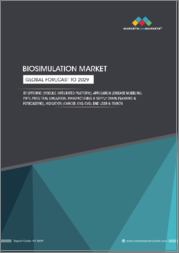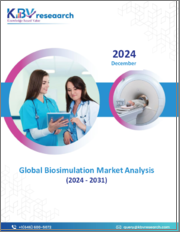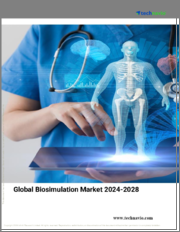
|
시장보고서
상품코드
1677860
바이오시뮬레이션 시장 규모, 점유율, 성장 분석 : 제품별, 용도별, 치료 분야별, 배포별, 가격별, 최종 용도별, 지역별 - 산업 예측(2025-2032년)Biosimulation Market Size, Share, and Growth Analysis, By Product (Software, Services), By Application (Drug Development, Drug Discovery), By Therapeutic Area, By Deployment Model, By Pricing Model, By End Use, By Region - Industry Forecast 2025-2032 |
||||||
바이오시뮬레이션 시장 규모는 2023년에 40억 달러, 예측 기간(2025-2032년)의 CAGR은 17.2%로, 2024년 46억 9,000만 달러에서 2032년에는 166억 9,000만 달러로 성장할 전망입니다.
시뮬레이션 소프트웨어 시장은 의료 용도의 발전과 자동차, 전자, 항공우주 등의 분야에서 폭넓게 활용되고 있는 것을 배경으로 크게 성장하고 있습니다. 이러한 툴은 시스템의 동작과 상호 작용을 분석하기 위한 수학적 모델을 채택하여 프로토타입을 만들고 실제 물체의 시뮬레이션을 가능하게 합니다. 시뮬레이션 소프트웨어의 주요 이점으로는 교육 및 제조 비용 절감, 장비 및 재료 품질 향상, 제품 리콜에 따른 위험 최소화, 물리적 상호 작용을 줄이면서 프로세스 및 운영을 최적화하는 것 등이 있습니다. 디지털 기술의 중요성이 부각되면서 도입이 더욱 가속화되고 있습니다. 시뮬레이션 툴은 의료 전문가를 교육하고, 바이러스 확산을 모델링하고, 팬데믹 기간 중 직면한 도전에 대처하기 위한 효과적인 전략을 개발하는 데 도움이 되고 있습니다.
목차
서론
- 조사의 목적
- 조사 범위
- 정의
조사 방법
- 정보 조달
- 2차와 1차 데이터 방법
- 시장 규모 예측
- 시장의 전제조건과 제한
개요
- 세계 시장 전망
- 공급과 수요 동향 분석
- 부문별 기회 분석
시장 역학과 전망
- 시장 개요
- 시장 규모
- 시장 역학
- 촉진요인과 기회
- 억제요인과 과제
- Porter의 산업 분석
주요 시장 인사이트
- 주요 성공 요인
- 경쟁의 정도
- 주요 투자 기회
- 시장 에코시스템
- 시장의 매력 지수(2024년)
- PESTEL 분석
- 거시경제 지표
- 밸류체인 분석
- 가격 분석
- 사례 연구
- 규제 상황
- 특허 분석
바이오시뮬레이션 시장 규모 : 제품별 & CAGR(2025-2032)
- 시장 개요
- 소프트웨어
- 서비스
바이오시뮬레이션 시장 규모 : 용도별 & CAGR(2025-2032)
- 시장 개요
- 의약품 개발
- Drug Discovery
- 기타
바이오시뮬레이션 시장 규모 : 치료 분야별 & CAGR(2025-2032)
- 시장 개요
- 종양학
- 신경학
- 심장병학
- 기타
바이오시뮬레이션 시장 규모 : 배포별 & CAGR(2025-2032)
- 시장 개요
- 온프레미스
- 클라우드 기반
바이오시뮬레이션 시장 규모 : 가격별 & CAGR(2025-2032)
- 시장 개요
- 서브스크립션
- 소유
바이오시뮬레이션 시장 규모 : 최종 용도별 & CAGR(2025-2032)
- 시장 개요
- 제약·바이오테크놀러지 기업
- 임상시험수탁기관(CRO)
- 학술 조사기관
- 규제기관
바이오시뮬레이션 시장 규모 : 지역별 & CAGR(2025-2032)
- 북미
- 미국
- 캐나다
- 유럽
- 독일
- 스페인
- 프랑스
- 영국
- 이탈리아
- 기타 유럽 지역
- 아시아태평양
- 중국
- 인도
- 일본
- 한국
- 기타 아시아태평양
- 라틴아메리카
- 브라질
- 기타 라틴아메리카 지역
- 중동 및 아프리카
- GCC 국가
- 남아프리카공화국
- 기타 중동 및 아프리카
경쟁 정보
- 상위 5사의 비교
- 주요 기업의 시장 포지셔닝(2024년)
- 주요 시장 기업이 채택한 전략
- 최근 시장 동향
- 기업의 시장 점유율 분석(2024년)
- 주요 기업의 기업 개요
- 기업의 상세
- 제품 포트폴리오 분석
- 기업의 부문별 점유율 분석
- 매출의 전년대비 비교(2022-2024)
주요 기업 개요
- Simulations Plus, Inc.(USA)
- Dassault Systemes(France)
- Schrodinger, LLC(USA)
- ACD/Labs(Canada)
- Chemical Computing Group(Canada)
- Physiomics PLC(UK)
- Evidera(USA)
- In Silico Biosciences, Inc.(USA)
- INOSIM Software GmbH(Germany)
- Insilico Biotechnology AG(Germany)
- LeadInvent Technologies(India)
- Rosa & Co. LLC(USA)
- Genedata AG(Switzerland)
결론과 제안
KSA 25.04.18Biosimulation Market size was valued at USD 4.0 billion in 2023 and is poised to grow from USD 4.69 billion in 2024 to USD 16.69 billion by 2032, growing at a CAGR of 17.2% during the forecast period (2025-2032).
The simulation software market is witnessing significant growth, driven by advancements in medical applications and widespread utilization across sectors like automotive, electronics, and aerospace. These tools enable the creation of prototypes and the simulation of real-world objects by employing mathematical models to analyze system behaviors and interactions. Key benefits of simulation software include reduced training and manufacturing costs, enhanced equipment and material quality, and minimized risks associated with product recalls. The COVID-19 pandemic has further accelerated adoption, highlighting the importance of digital technologies in optimizing processes and operations while reducing physical interactions. Simulation tools have been instrumental in training healthcare professionals, modeling virus spread, and developing effective strategies to address challenges faced during the pandemic.
Top-down and bottom-up approaches were used to estimate and validate the size of the Biosimulation market and to estimate the size of various other dependent submarkets. The research methodology used to estimate the market size includes the following details: The key players in the market were identified through secondary research, and their market shares in the respective regions were determined through primary and secondary research. This entire procedure includes the study of the annual and financial reports of the top market players and extensive interviews for key insights from industry leaders such as CEOs, VPs, directors, and marketing executives. All percentage shares split, and breakdowns were determined using secondary sources and verified through Primary sources. All possible parameters that affect the markets covered in this research study have been accounted for, viewed in extensive detail, verified through primary research, and analyzed to get the final quantitative and qualitative data.
Biosimulation Market Segments Analysis
Global Biosimulation Market is segmented by Product, Application, Therapeutic Area, Deployment Model, Pricing Model, End Use and region. Based on Product, the market is segmented into Software and Services. Based on Application, the market is segmented into Drug Development, Drug Discovery and Others. Based on Therapeutic Area, the market is segmented into Oncology, Neurology, Cardiology and Others. Based on Deployment Model, the market is segmented into On-premise and Cloud-based. Based on Pricing Model, the market is segmented into Subscription and Ownership. Based on End Use, the market is segmented into Pharmaceutical & Biotechnology Companies, Contract Research Organizations (CROs), Academic & Research Institutes and Regulatory Authorities. Based on region, the market is segmented into North America, Europe, Asia Pacific, Latin America and Middle East & Africa.
Driver of the Biosimulation Market
The biosimulation market is significantly driven by the growing demand for cost-effective solutions across various industries, as companies strive to minimize operating expenses. This trend has resulted in an increase in the adoption of simulation software, which allows businesses to conduct virtual testing and analysis. By leveraging these advanced tools, organizations can effectively reduce the expenses associated with physical prototypes and traditional testing methods, leading to substantial savings. Consequently, the ability to perform efficient simulations not only accelerates the development process but also supports businesses in making informed decisions, further propelling the growth of the biosimulation market.
Restraints in the Biosimulation Market
Although biosimulation offers numerous benefits, the considerable initial expenses tied to simulation software pose a notable constraint. The costs related to licensing, necessary hardware upgrades, and employee training can be quite substantial, creating a financial burden, particularly for small and medium-sized enterprises (SMEs). This high upfront investment can deter some companies from adopting such software solutions, especially those operating within tight budgetary constraints. As a result, the financial barrier may restrict the wider implementation of biosimulation technology, hindering its potential growth and utilization in the market for organizations with limited resources.
Market Trends of the Biosimulation Market
The biosimulation market is experiencing significant growth, driven predominantly by the expansion of artificial intelligence (AI) technologies. AI enhances the accuracy and efficiency of biosimulations, delivering predictive insights that are crucial for industries like healthcare and autonomous vehicles, where navigating complex systems is essential. This integration not only streamlines the simulation process but also allows for real-time optimization of performance, making these tools invaluable for research and development. As industries increasingly recognize the strategic advantages offered by AI-driven biosimulations, the market is projected to flourish, attracting investments and fostering innovations that advance scientific discovery and improve outcomes across various applications.
Table of Contents
Introduction
- Objectives of the Study
- Scope of the Report
- Definitions
Research Methodology
- Information Procurement
- Secondary & Primary Data Methods
- Market Size Estimation
- Market Assumptions & Limitations
Executive Summary
- Global Market Outlook
- Supply & Demand Trend Analysis
- Segmental Opportunity Analysis
Market Dynamics & Outlook
- Market Overview
- Market Size
- Market Dynamics
- Drivers & Opportunities
- Restraints & Challenges
- Porters Analysis
- Competitive rivalry
- Threat of substitute
- Bargaining power of buyers
- Threat of new entrants
- Bargaining power of suppliers
Key Market Insights
- Key Success Factors
- Degree of Competition
- Top Investment Pockets
- Market Ecosystem
- Market Attractiveness Index, 2024
- PESTEL Analysis
- Macro-Economic Indicators
- Value Chain Analysis
- Pricing Analysis
- Case Studies
- Regulatory Landscape
- Patent Analysis
Global Biosimulation Market Size by Product & CAGR (2025-2032)
- Market Overview
- Software
- Services
Global Biosimulation Market Size by Application & CAGR (2025-2032)
- Market Overview
- Drug Development
- Drug Discovery
- Others
Global Biosimulation Market Size by Therapeutic Area & CAGR (2025-2032)
- Market Overview
- Oncology
- Neurology
- Cardiology
- Others
Global Biosimulation Market Size by Deployment Model & CAGR (2025-2032)
- Market Overview
- On-premise
- Cloud-based
Global Biosimulation Market Size by Pricing Model & CAGR (2025-2032)
- Market Overview
- Subscription
- Ownership
Global Biosimulation Market Size by End Use & CAGR (2025-2032)
- Market Overview
- Pharmaceutical & Biotechnology Companies
- Contract Research Organizations (CROs)
- Academic & Research Institutes
- Regulatory Authorities
Global Biosimulation Market Size & CAGR (2025-2032)
- North America (Product, Application, Therapeutic Area, Deployment Model, Pricing Model, End Use)
- US
- Canada
- Europe (Product, Application, Therapeutic Area, Deployment Model, Pricing Model, End Use)
- Germany
- Spain
- France
- UK
- Italy
- Rest of Europe
- Asia Pacific (Product, Application, Therapeutic Area, Deployment Model, Pricing Model, End Use)
- China
- India
- Japan
- South Korea
- Rest of Asia-Pacific
- Latin America (Product, Application, Therapeutic Area, Deployment Model, Pricing Model, End Use)
- Brazil
- Rest of Latin America
- Middle East & Africa (Product, Application, Therapeutic Area, Deployment Model, Pricing Model, End Use)
- GCC Countries
- South Africa
- Rest of Middle East & Africa
Competitive Intelligence
- Top 5 Player Comparison
- Market Positioning of Key Players, 2024
- Strategies Adopted by Key Market Players
- Recent Developments in the Market
- Company Market Share Analysis, 2024
- Company Profiles of All Key Players
- Company Details
- Product Portfolio Analysis
- Company's Segmental Share Analysis
- Revenue Y-O-Y Comparison (2022-2024)
Key Company Profiles
- Simulations Plus, Inc. (USA)
- Company Overview
- Business Segment Overview
- Financial Updates
- Key Developments
- Dassault Systemes (France)
- Company Overview
- Business Segment Overview
- Financial Updates
- Key Developments
- Schrodinger, LLC (USA)
- Company Overview
- Business Segment Overview
- Financial Updates
- Key Developments
- ACD/Labs (Canada)
- Company Overview
- Business Segment Overview
- Financial Updates
- Key Developments
- Chemical Computing Group (Canada)
- Company Overview
- Business Segment Overview
- Financial Updates
- Key Developments
- Physiomics PLC (UK)
- Company Overview
- Business Segment Overview
- Financial Updates
- Key Developments
- Evidera (USA)
- Company Overview
- Business Segment Overview
- Financial Updates
- Key Developments
- In Silico Biosciences, Inc. (USA)
- Company Overview
- Business Segment Overview
- Financial Updates
- Key Developments
- INOSIM Software GmbH (Germany)
- Company Overview
- Business Segment Overview
- Financial Updates
- Key Developments
- Insilico Biotechnology AG (Germany)
- Company Overview
- Business Segment Overview
- Financial Updates
- Key Developments
- LeadInvent Technologies (India)
- Company Overview
- Business Segment Overview
- Financial Updates
- Key Developments
- Rosa & Co. LLC (USA)
- Company Overview
- Business Segment Overview
- Financial Updates
- Key Developments
- Genedata AG (Switzerland)
- Company Overview
- Business Segment Overview
- Financial Updates
- Key Developments



















